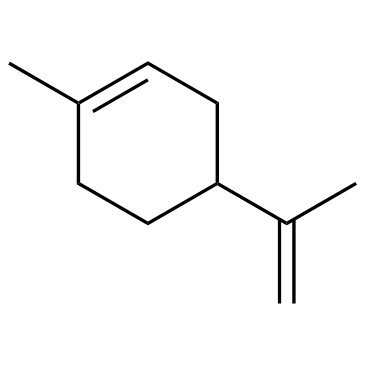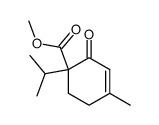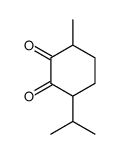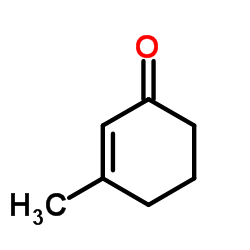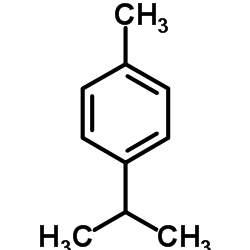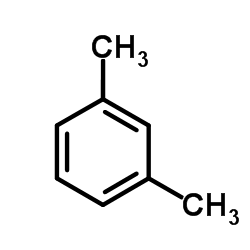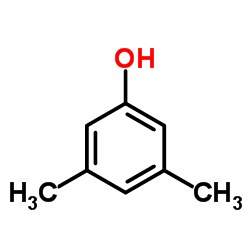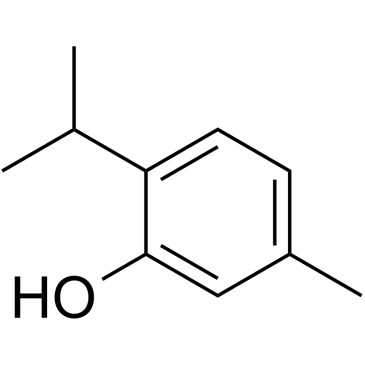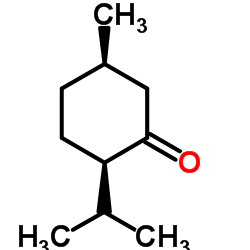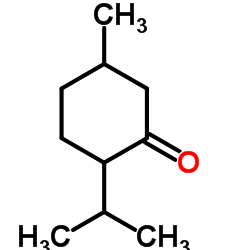89-81-6
| 中文名 | 3甲基-6-(1-甲基乙基)-2-环己烯-1-酮 |
|---|---|
| 英文名 | piperitone |
| 中文别名 |
胡椒酮
3-甲基-6-(1-甲基乙基)-2-环己烯-1-酮 |
| 英文别名 |
PIPERTONE
PIPERITONE PIPERITONE(SG) 3-methyl-6-(1-methylethyl)-2-cyclohexen-1-one P-MENTH-1-EN-3-ONE 3-Carvomenthenone 6-isopropyl-3-methyl-2-cyclohexen-1-one PIPERITON 3-methyl-6-isopropylcyclohex-2-en-1-one 1-Methyl-4-isopropyl-1-cyclohexen-3-one PIPERITONE WITH GC 1-P-MENTHEN-3-ONE 6-isopropyl-3-methylcyclohex-2-en-1-one p-Mentha-1-ene-3-one cinchonidine |
| 描述 | 胡椒酮是一种强大的驱避剂和抗食欲剂。胡椒酮对圆尾水蚤成虫、新产卵和新生幼虫有很强的毒性。杀虫活性[1]。 |
|---|---|
| 相关类别 | |
| 体外研究 | 从Cymbopogon schoenanthus(C.schoenanthus)[1]中分离的胡椒酮。 |
| 体内研究 | 研究了不同发育阶段斑纹胼胝体(C.maculatus)的粗挥发油及其主要成分胡椒酮的杀虫活性。胡椒酮对黄斑梭菌成虫有毒,LC50值为1.6μL/L。胡椒酮抑制新产卵和新生幼虫的发育,但对种子内发育的个体的毒性低于粗提取物。胡椒酮的杀卵活性最强。所有卵在6.7μL/L时流产。胡椒酮(10μM)杀死所有新生幼虫[1]。动物模型:50对黄斑梭菌成虫[1]剂量:6.7、10、16.7或33.3μL/L给药:24小时结果:哌立顿的毒性比原油更大,因为记录的LC50为哌立通的1.6μL/L,而原油的LC50为2.7μL/L。 |
| 参考文献 |
| 密度 | 0.93g/cm3 |
|---|---|
| 沸点 | 233ºC |
| 熔点 | -29ºC |
| 分子式 | C10H16O |
| 分子量 | 152.23 |
| 闪点 | 90.9ºC |
| 精确质量 | 152.12000 |
| PSA | 17.07000 |
| LogP | 2.56780 |
| 外观性状 | 透明,淡黄色至黄色液体 |
| 折射率 | -60 ° (C=4, benzene) |
| 储存条件 | 室温,干燥,密封 |
| 稳定性 | 1. 存在于烤烟烟叶、白肋烟烟叶、香料烟烟叶中。 2. 天然存在于桉树油、薄荷油、香茅油中。 3. 单环单萜类化合物有一对对映体,均有天然存在,右旋体有樟脑气味。 4. 常以两种光学异构体分别存在于多种精油中。 |
| 计算化学 | 1.疏水参数计算参考值(XlogP):2.2 2.氢键供体数量:0 3.氢键受体数量:1 4.可旋转化学键数量:1 5.互变异构体数量:8 6.拓扑分子极性表面积17.1 7.重原子数量:11 8.表面电荷:0 9.复杂度:189 10.同位素原子数量:0 11.确定原子立构中心数量:0 12.不确定原子立构中心数量:1 13.确定化学键立构中心数量:0 14.不确定化学键立构中心数量:0 15.共价键单元数量:1 |
| 更多 | 1. 性状:无色至浅黄色液体,具有辛香薄荷香。 2. 溶解性:几乎不溶于水,溶于乙醇等有机溶剂中。 3. 沸点(ºC):232~235 4. 相对密度:0.9344 5.折射率:1.4848 6. 左旋体沸点:109.5~110.5(1.99kpa) 7. 相对密度:0.9324 8.折射率:1.4832 |
|
Section I.Chemical Product and Company Identification Chemical Name Piperitone Portland OR Synonym2-Cyclohexen-1-one, 3-methyl-6-(1-methylethyl)- (CA INDEX NAME); 1-p-Menthen-3-one; 6-Isopropyl-3-methyl-2-cyclohexen-1-one Chemical FormulaC10H16O
89-81-6 CAS Number Section II.Composition and Information on Ingredients Chemical NameCAS Number Percent (%)TLV/PELToxicology Data Piperitone89-81-6Min. 94.0 (GC) Not available.Rat LD50 (oral) 2450 mg/kg Mouse LD50 (subcutaneous) 1420 mg/kg Section III. Hazards Identification Acute Health EffectsIrritating to eyes and skin on contact. Inhalation causes irritation of the lungs and respiratory system. Inflammation of the eye is characterized by redness, watering, and itching. Skin inflammation is characterized by itching, scaling, reddening, or, occasionally, blistering. Follow safe industrial hygiene practices and always wear proper protective equipment when handling this compound. Chronic Health EffectsCARCINOGENIC EFFECTS : Not available. MUTAGENIC EFFECTS : Not available. TERATOGENIC EFFECTS : Not available. DEVELOPMENTAL TOXICITY: Not available. Repeated or prolonged exposure to this compound is not known to aggravate existing medical conditions. Section IV.First Aid Measures Eye ContactCheck for and remove any contact lenses. In case of contact, immediately flush eyes with plenty of water for at least 15 minutes. Get medical attention. Skin ContactIn case of contact, immediately flush skin with plenty of water. Remove contaminated clothing and shoes. Wash clothing before reuse. Thoroughly clean shoes before reuse. Get medical attention. If the victim is not breathing, perform mouth-to-mouth resuscitation. Loosen tight clothing such as a collar, tie, belt or Inhalation waistband. If breathing is difficult, oxygen can be administered. Seek medical attention if respiration problems do not improve. INDUCE VOMITING by sticking finger in throat. Lower the head so that the vomit will not reenter the mouth and throat. Ingestion Loosen tight clothing such as a collar, tie, belt or waistband. If the victim is not breathing, perform mouth-to-mouth resuscitation. Examine the lips and mouth to ascertain whether the tissues are damaged, a possible indication that the toxic material was ingested; the absence of such signs, however, is not conclusive. Section V.Fire and Explosion Data Not available. Combustible.Auto-Ignition Flammability Flash PointsFlammable LimitsNot available. Not available. These products are toxic carbon oxides (CO, CO2). Combustion Products Fire HazardsNot available. Risks of explosion of the product in presence of mechanical impact: Not available. Explosion Hazards Risks of explosion of the product in presence of static discharge: Not available. Fire Fighting Media SMALL FIRE: Use DRY chemical powder. LARGE FIRE: Use water spray, fog or foam. DO NOT use water jet. and Instructions Consult with local fire authorities before attempting large scale fire-fighting operations. Continued on Next Page Piperitone Section VI.Accidental Release Measures Spill CleanupCombustible material. Irritating material. Keep away from heat. Mechanical exhaust required. Stop leak if without risk. Finish cleaning the spill by rinsing any Instructions contaminated surfaces with copious amounts of water. Consult federal, state, and/or local authorities for assistance on disposal. Section VII. Handling and Storage COMBUSTIBLE. IRRITANT. Keep away from heat. Mechanical exhaust required. Avoid excessive heat and light. Do not Handling and Storage breathe gas/fumes/ vapor/spray. Information Always store away from incompatible compounds such as oxidizing agents. Section VIII. Exposure Controls/Personal Protection Provide exhaust ventilation or other engineering controls to keep the airborne concentrations of vapors below their respective Engineering Controls threshold limit value. Ensure that eyewash station and safety shower is proximal to the work-station location. Splash goggles. Lab coat. Vapor respirator. Boots. Gloves. Suggested protective clothing might not be sufficient; consult a Personal Protection specialist BEFORE handling this product. Be sure to use a MSHA/NIOSH approved respirator or equivalent. Exposure LimitsNot available. Section IX. Physical and Chemical Properties Liquid. (Clear, light yellow ~ yellow.)Solubility Physical state @ 20°CInsoluble in water. 0.94 (water=1) Specific Gravity Molecular Weight152.23Partition Coefficient LOG Pow: 2.5 Boiling Point235°C (455°F)Vapor PressureNot available. -29°C (-20.2°F)Not available. Melting PointVapor Density Refractive Index1.48VolatilityNot available. Not available.Not available. Critical TemperatureOdor ViscosityNot available.TasteNot available. Section X.Stability and Reactivity Data This material is stable if stored under proper conditions. (See Section VII for instructions) Stability Conditions of InstabilityAvoid excessive heat and light. Incompatibilities Reactive with oxidizing agents. Section XI. Toxicological Information OT0257000 RTECS Number Eye Contact. Ingestion. Inhalation. Routes of Exposure Rat LD50 (oral) 2450 mg/kg Toxicity Data Mouse LD50 (subcutaneous) 1420 mg/kg CARCINOGENIC EFFECTS : Not available. Chronic Toxic Effects MUTAGENIC EFFECTS : Not available. TERATOGENIC EFFECTS : Not available. DEVELOPMENTAL TOXICITY: Not available. Repeated or prolonged exposure to this compound is not known to aggravate existing medical conditions. Irritating to eyes and skin on contact. Inhalation causes irritation of the lungs and respiratory system. Inflammation of the eye Acute Toxic Effects is characterized by redness, watering, and itching. Skin inflammation is characterized by itching, scaling, reddening, or, occasionally, blistering. Follow safe industrial hygiene practices and always wear proper protective equipment when handling this compound. Section XII.Ecological Information EcotoxicityNot available. Not available. Environmental Fate Continued on Next Page Piperitone Section XIII. Disposal Considerations Waste DisposalRecycle to process, if possible. Consult your local regional authorities. You may be able to dissolve or mix material with a combustible solvent and burn in a chemical incinerator equipped with an afterburner and scrubber system. Observe all federal, state and local regulations when disposing of the substance. Section XIV. Transport Information Not a DOT controlled material (United States). DOT Classification PIN NumberNot applicable. Proper Shipping NameNot applicable. Packing Group (PG)Not applicable. DOT Pictograms Section XV. Other Regulatory Information and Pictograms TSCA Chemical InventoryThis compound is ON the EPA Toxic Substances Control Act (TSCA) inventory list. (EPA) WHMIS ClassificationCLASS B-3: Combustible liquid with a flash point between 37.8°C (100°F) and 93.3°C (200°F). On DSL. (Canada) EINECS Number (EEC) 201-942-7 EEC Risk StatementsR36/37/38- Irritating to eyes, respiratory system and skin. SECTION 16 - ADDITIONAL INFORMATION N/A |
CHEMICAL IDENTIFICATION
HEALTH HAZARD DATAACUTE TOXICITY DATA
|
| 上游产品 7 | |
|---|---|
| 下游产品 10 | |
| 海关编码 | 2914299000 |
|---|---|
| 中文概述 | 2914299000. 其他不含其他含氧基的环烷酮、环烯酮或环萜烯酮. 增值税率:17.0%. 退税率:13.0%. 监管条件:无. 最惠国关税:5.5%. 普通关税:30.0% |
| 申报要素 | 品名, 成分含量, 用途, 丙酮报明包装 |
| Summary | 2914299000. other cyclanic, cyclenic or cyclotherpenic ketones without other oxygen function. VAT:17.0%. Tax rebate rate:13.0%. . MFN tariff:5.5%. General tariff:30.0% |


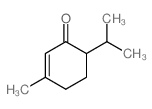

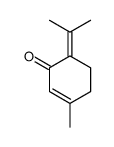
![6-isopropyl-3-methyl-2-[(dimethylthiocarbamoyl)oxy]-2-cyclohexen-1-one结构式](https://image.chemsrc.com/caspic/001/112621-61-1.png)

